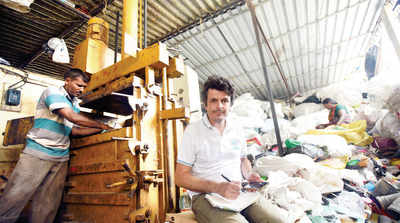‘Govandi slums not as bad as those in Dhaka, Kathmandu’

Frenchman Julein Eyrard, an expert in water, sanitation, and hygiene, was in the city a few days ago to study the water and hygiene conditions at one of Mumbai’s most densely populated areas, Govandi.
Eyrard is an advisor to NGO ‘Fight Hunger Foundation’, whose main concern is the treatment of the malnourished children and supporting their families. Regarding conditions in Govandi, he did not paint an entirely gloom-and-doom picture. “If I have to compare the Govandi slums to the ones I have seen in Kenya, Dhaka, and a few areas in Kathmandu, the condition (in Govandi) is not abysmal,” he said. “I say this because Govandi has some/limited access to basic services such as water and sewage. But the main issue is there aren’t enough toilets,” he told Mumbai Mirror.
Eyrard’s assessment suggested there were 10 public toilets (there are approximately 10 seats for women and 10 for men ) for a population of nearly 65,000 people living in the Sathe Nagar transit camp and Umer Khadi in Govandi.
“This means one in every five children in Govandi is malnourished. But a treatment is only possible if we maintain proper hygiene and sanitation levels. It helps prevent the condition,” he said.
What would improve the situation drastically is the restoration of the 24-hour water supply, he said. “In Mumbai, water is divided into sections. So, when a section of a pipeline is closed, its pressure is negative. This is susceptible to contamination. Dirt and stagnant water can enter the network from small leakages. This will contaminate the water,” he explained. “We can save and treat rainwater. Simultaneously, the drainage and sewage system must be improved. It’s currently clogged with plastic and waste.”
Eyrard laid emphasis on the basics to remove the solid waste from the streets. “Most of the homes in the city have a toilet with facilities. It is the lower poverty line that is suffering. But on the upside, the houses are clean and organised. People in Govandi are taking good care of their personal spaces,” he said.
Eyrard had visited Dharavi a few years ago and found that the Asia’s largest slum was grappling with similar problems. “What does set it apart is that in Dharavi, you have more economical activities. There are more toilets for the residents staying there,” he added. “And they don’t have a dumping ground, which is a huge respite.”
Eyrard is an advisor to NGO ‘Fight Hunger Foundation’, whose main concern is the treatment of the malnourished children and supporting their families. Regarding conditions in Govandi, he did not paint an entirely gloom-and-doom picture. “If I have to compare the Govandi slums to the ones I have seen in Kenya, Dhaka, and a few areas in Kathmandu, the condition (in Govandi) is not abysmal,” he said. “I say this because Govandi has some/limited access to basic services such as water and sewage. But the main issue is there aren’t enough toilets,” he told Mumbai Mirror.
Eyrard’s assessment suggested there were 10 public toilets (there are approximately 10 seats for women and 10 for men ) for a population of nearly 65,000 people living in the Sathe Nagar transit camp and Umer Khadi in Govandi.
“To add to it, there’s a dumping ground nearby. And the area is infested with mosquitoes, flies, rats, and rodents that can spread diseases such as leptospirosis,” he observed. “What worries me more than the putrid smell is the smoke that comes with burning of the garbage,” he said. He said that nearly 3.4% children in Govandi suffer from severe acute malnutrition (“if untreated, they could die in a couple of weeks,” he said), while 19.5% suffer from moderate to acute malnutrition.
“This means one in every five children in Govandi is malnourished. But a treatment is only possible if we maintain proper hygiene and sanitation levels. It helps prevent the condition,” he said.
What would improve the situation drastically is the restoration of the 24-hour water supply, he said. “In Mumbai, water is divided into sections. So, when a section of a pipeline is closed, its pressure is negative. This is susceptible to contamination. Dirt and stagnant water can enter the network from small leakages. This will contaminate the water,” he explained. “We can save and treat rainwater. Simultaneously, the drainage and sewage system must be improved. It’s currently clogged with plastic and waste.”
Eyrard laid emphasis on the basics to remove the solid waste from the streets. “Most of the homes in the city have a toilet with facilities. It is the lower poverty line that is suffering. But on the upside, the houses are clean and organised. People in Govandi are taking good care of their personal spaces,” he said.
Eyrard had visited Dharavi a few years ago and found that the Asia’s largest slum was grappling with similar problems. “What does set it apart is that in Dharavi, you have more economical activities. There are more toilets for the residents staying there,” he added. “And they don’t have a dumping ground, which is a huge respite.”
GALLERIES View more photos












